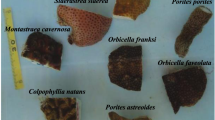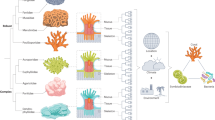Abstract
The study of coral diseases requires an integrated approach that includes a combination of field and laboratory methods. By combining and building upon information available from multiple disciplines, within both field and laboratory applications, we have been successful in characterizing a number of coral diseases. To illustrate the utility of the integrative approach two very different coral diseases, black band disease and plague, are discussed in detail. Comparison of our ongoing characterization of each disease demonstrates that, within the integrative approach, different combinations of microbiological, microsensor, molecular, and physiologic techniques are required. The pathobiology of black band disease, which consists of a complicated, synergistic microbial consortium functioning around a dynamic sulfur cycle, is slowly being unraveled using a combination of methods. Our study of plague, on the other hand, has progressed in a very different manner that is controlled by the fact that this disease has, to date, emerged in three forms on reefs of the Florida Keys. The study of plague types I, II, and III will be detailed to illustrate the difficulty of characterizing a disease that rapidly evolves in the natural environment of the reef. Our ongoing study of additional (also very different) coral diseases will be summarized from the perspective of combined methodologies to illustrate the range and magnitude of questions that must be addressed and answered in order to understand coral disease pathogenesis and thus coral disease etiology.
Similar content being viewed by others
References
Altschul, S. F., T. L. Madden, A. A. Scaffer, J. Zhang, Z. Zhang, W. Miller & D. J. Lipman, 1997. Gapped BLAST and PSI-BLAST: a new generation of protein database search programs. Nucl. Acids Res. 25: 3389–3402.
Antonius, A., 1973. New observations on coral destruction in reefs. 10th Mtg. Assoc. Isl. Mar. Lab. Carib. 10: 3 (abstract).
Antonius, A., 1981. Coral reef pathology: A review. Proc. 4th Intl. Coral Reef Symp., Univ. Philippines, Manila, 2: 3–6.
Aronson, R. B. & W. F. Precht, 2001. White-band disease and the changing face of Caribbean coral reefs. Hydrobiologia 460: 25–38.
Boyd, R. F. & B. G. Hoerl, 1981. Basic Medical Microbiology. Little, Brown & Co., Boston: 766 pp.
Brosius, J., J. L. Palmer, J. P. Kennedy & H. F. Naler, 1978. Complete nucleotide sequence of a 16S ribosomal RNA gene from Escherichia coli. Proc. Natl. Acad. Sci. USA 75: 4801–4805.
Carlton, R. G. & L. L. Richardson, 1995. Oxygen and sulfide dynamics in a horizontally migrating cyanobacterial mat: Black band disease of corals. FEMS Microbiol. Ecol. 18: 155–162.
Carlton, R. G. & R. G. Wetzel, 1987. Distributions and fates of oxygen in periphyton communities. Can. J. Bot. 65: 1031–1037.
Castenholz, R. & J. Waterbury, 1994. Oxygenic Photosynthetic Bacteria. In Bergeys's Manual of Determinative Bacteriology, Williams & Wilkins, Baltimore.
Castenholz, R. W., 1982. Motility and Taxes. In Carr, N. G. & B.A. Whitton (eds), The Biology of Cyanobacteria. University of California Press, Berkeley: 413–440.
Done, T. J., 1992. Phase shifts in coral reef communities and their ecological significance. Hydrobiologia 247: 121–132.
Ducklow, H. W. & R. Mitchell, 1979. Observations on naturally and artificially diseased tropical corals: A scanning electron microscope study. Microb. Ecol. 5: 215–223.
Dustan, P., 1977. Vitality of reef coral populations off Key Largo, Florida: Recruitment and mortality. Env. Geol. 2: 51–58.
Dustan, P. & J. C. Halas, 1987. Changes in the reef-coral community of Carysfort Reef, Key Largo, Florida: 1974–1982. Coral Reefs 6: 91–106.
Edmunds, P. J., 1991. Extent and effect of black band disease on Caribbean reefs. Coral Reefs 10: 161–165.
Garrett, P. & H. W. Ducklow, 1975. Coral disease in Bermuda. Nature 253: 349–350.
Geiser, D. M., J. W. Taylor, K. B. Ritchie & G. W. Smith, 1998. Cause of sea fan death in the West Indies. Nature 394: 137–138.
Gladfelter, W. B., 1982. White band disease and Acropora palmata: Implications for the structure and growth of shallow reefs. Bull. Mar. Sci. 32: 639–643.
Gladfelter, W. B., E. H. Gladfelter, R. K. Monahan, J. C. Ogden & R. F. Dill, 1977. Environmental studies of Buck Island Reef National Monument, St. Croix US Virgin Islands. Spec. Rep. Nat. Park Serv. US Dept. Int. 1–73.
Harvell, C. D., K. Kim, J. M. Burkholder, R. R. Colwell, P. R. Epstein, D. J. Grimes, E. E. Hofmann, E. K. Lipp, A. D. M.E. Osterhaus, R. M. Overstreet, J. W. Porter, G. W. Smith, G.R. Vasta, 1999. Emerging marine diseases – climate links and anthropogenic factors. Science 285: 1505–1510.
Hayes, R. L. & N. I. Goreau, 1998. The significance of emerging diseases in the tropical coral reef ecosystem. Rev. Biol. Trop: 173–185.
Hughes, T. P., 1994. Catastrophies, phase shifts and large scale degradation of a Caribbean coral reef. Science 265: 1547–1549.
Jørgensen, B., 1982. Ecology of the bacteria of the sulphur cycle with special reference to anoxic-oxic interface environments. Phil. Trans. r. Soc., Lond. 298: 543–561.
Kim, K., D. Harvell, P. D. Kim, G.W. Smith & S. M. Merkel, 1999. Fungal disease resistance of Caribbean sea fan corals (Gorgonia spp.). Mar. Biol. 136: 259–267.
Kushmaro, A., Y. Loya, M. Fine & E. Rosenberg, 1996. Bacterial infection and coral bleaching. Nature 380: 396.
Kuta, K., 2000. Black band disease of corals: Ecology and physiology of Phormidium corallyticum. Doctoral dissertation, Florida International University.
Kuta, K. G. & L. Richardson, 1996. Abundance and distribution of black band disease of corals in the northern Florida Keys. Coral Reefs 15: 219–223.
Lessios, H. A., 1988. Mass mortality of Diadema antillarum in the Caribbean – what have we learned. Ann. Rev. Ecol. Syst. 19: 371–339.
Lewis, M. R. & J. C. Smith, 1983. A small volume, short incubationtime method for measurement of photosynthesis as a function of incident irradiance. Mar. Ecol. Prog. Ser. 13: 99–102.
Manual of Methods for General Bacteriology, 1981. In Gerhardt, P., R. G. E. Murray, R. N. Costilow, E.W. Nester, W. A. Wood, N. R. Krieg & G. B. Phillips (eds), American Society for Microbiology Press, Washington DC: 524 pp.
Mitchell, R. & I. Chet, 1975. Bacterial attack of corals in polluted seawater. Microb. Ecol. 2: 227–233.
Nagelkerken, I., K. Buchan, G. W. Smith, K. Bonair, P. Bush, J. Garzon-Ferreira, L. Botero, P. Gayle, C. Heberer, C. Petrovic, L. Pors & P. Yoshioka, 1997a. Widespread disease in Caribbean sea fans: I. Spreading and general characteristics. Proc. 8th Intl. Coral Reef Symp. I: 679–682.
Nagelkerken, I., K. Buchan, G. W. Smith, K. Bonair, P. Bush, J. Garzon-Ferreira, L. Botero, P. Gayle, C. D. Harvell, C. Heberer, K. Kim, C. Petrovic, L. Pors & P. Yoshioka, 1997b. Widespread disease in Caribbean sea fans: II. Patterns of infection and tissue loss. Mar. Ecol. Prog. Ser. 160: 255–263.
Peters, E., 1984. A survey of cellular reactions to environmental stress and disease in Caribbean scleractinian corals. Helgol. Meer. 37: 113–137.
Peters, E., J. Oprandy & P. Yevich, 1983. Possible cause of “white band disease” in Caribbean corals. J. Invert. Pathol. 41: 394–396.
Ramos-Flores, T., 1983. Lower marine fungus associated with black line disease in star corals (Montastraea annularis). Biol. Bull. 165: 429–435.
Revsbech, N. P., 1989. Diffusion characteristics of microbial communities determined by use of oxygen microsensors. J. Microb. Meth. 9: 111–122.
Revsbech, N. P. & B. B. Jørgensen, 1986. Microelectrodes: Their use in microbial ecology. Adv. Microb. Ecol. 9: 292–352.
Revsbech, N. P. & D. M. Ward, 1983. Oxygen microelectrode insensitive to medium chemical compositions: Use in an acid microbial mat dominated by Cyanidium caldarium. Appl. Env. Microbiol. 45: 766–759.
Richardson, L. L., 1998. Coral diseases: what is really known? Trends Ecol. Evol. 1311: 438–443.
Richardson, L. L. & R. W. Castenholz, 1987. Vertical movements of the cyanobacterium Oscillatoria terebriformis in a sulfide-rich hot spring microbial mat. Apl. envir. Microbiol. 53: 2142–2150.
Richardson, L. L., W. M. Goldberg, R. G. Carlton & J. C. Halas, 1998a. Coral disease outbreak in the Florida Keys: Plague type II. Rev. Biol. Trop. 46: 187–198.
Richardson, L., W. Goldberg, K. Kuta, R. Aronson, G. Smith, K. Ritchie, J. Halas, J. Feingold & S. Miller, 1998b. Florida's mystery coral killer explained. Nature 392: 557–558.
Richardson, L., K. Kuta, S. Schnell & R. Carlton, 1997. Ecology of the black band disease microbial consortium. Proc. 8th Intl. Coral Reef Symp., Smithsonian Trop. Res. Inst., Panama 1: 597–600.
Ritchie, K. & G. Smith, 1995a. Carbon-source utilization patterns of coral-associated marine heterotrophs. J. mar. Biotechnol. 3: 107–109.
Ritchie, K. & G. Smith, 1995b. Preferential carbon utilitzation by surface bacterial communities from water mass, normal, and white-band diseased Acropora cervicornis. Mol. mar. Biol. Biotechnol. 4: 345–352.
Ritchie, K. B. & G. W. Smith, 1998. Description of type II white band disease in acroporid corals. Rev. Biol. Trop. 46: 199–203.
Ritchie, K. B., S.W. Polson & G.W. Smith, 2001. Microbial disease causation in marine invertebrates: problems, practices, and future prospects. Hydrobiologia 460: 131–139.
Rützler, K. & D. Santavy, 1983. The black band disease of Atlantic reef corals. I. Description of the cyanophyte pathogen. P.S.Z.N.I: Mar. Ecol. 4: 301–319.
Rützler, K., D. Santavy & A. Antonius, 1983. The black band disease of Atlantic reef corals. III. Distribution, ecology and development. PSZNI: Mar. Ecol. 4: 329–358.
Schnell, S., B. Assmus & L. L. Richardson, 1996. Role of sulfate-reducing bacteria in the black band disease of corals. Biospecktrum p. 116 (abstract).
Shinn, E. A., G. W. Smith, J. M. Prospero, P. Betzer, M. L. Hayes, V. Garrison & R. T. Barber, 2000. African dust and the demise of Caribbean coral reefs. Geophys. Res. Lett. 27: 3029–3032.
Smith, G. W. & S. S. Hayasaka, 1982. Nitrogenase activity associated with Halodule wrightii roots. Apl. env. Microbiol. 43: 1244–1248.
Smith, G. W., C. D. Harvell & K. Kim, 1998. Observations on the pathogenesis of sea fans infected with Aspergillus sp. Rev. Biol. Trop. 46: 205–208.
Smith, G. W., L. Ives, I. Nagelkerken & K. Ritchie, 1996. Aspergillosis associated with Caribbean sea fan mortalities. Nature 382: 487.
Taylor, D., 1983. The black band disease of Atlantic reef corals. II. Isolation, cultivation, and growth of Phormidium corallyticum. P.S.Z.N.I.:Mar. Ecol. 4: 320–328.
Vismann, B., 1991. Sulfide tolerance: physiological mechanisms and ecological implications. Ophelia 34: 1–27.
Vogel, S., 1981. Life in Moving Fluids. Willard Grant, Boston.
Williams, E. & L. Bunkley-Williams, 1990. The world-wide coral reef bleaching cycle and related sources of coral mortality. Atoll Res. Bull. 335: 1–71.
Author information
Authors and Affiliations
Rights and permissions
About this article
Cite this article
Richardson, L.L., Smith, G.W., Ritchie, K.B. et al. Integrating microbiological, microsensor, molecular, and physiologic techniques in the study of coral disease pathogenesis. Hydrobiologia 460, 71–89 (2001). https://doi.org/10.1023/A:1013187723831
Issue Date:
DOI: https://doi.org/10.1023/A:1013187723831




